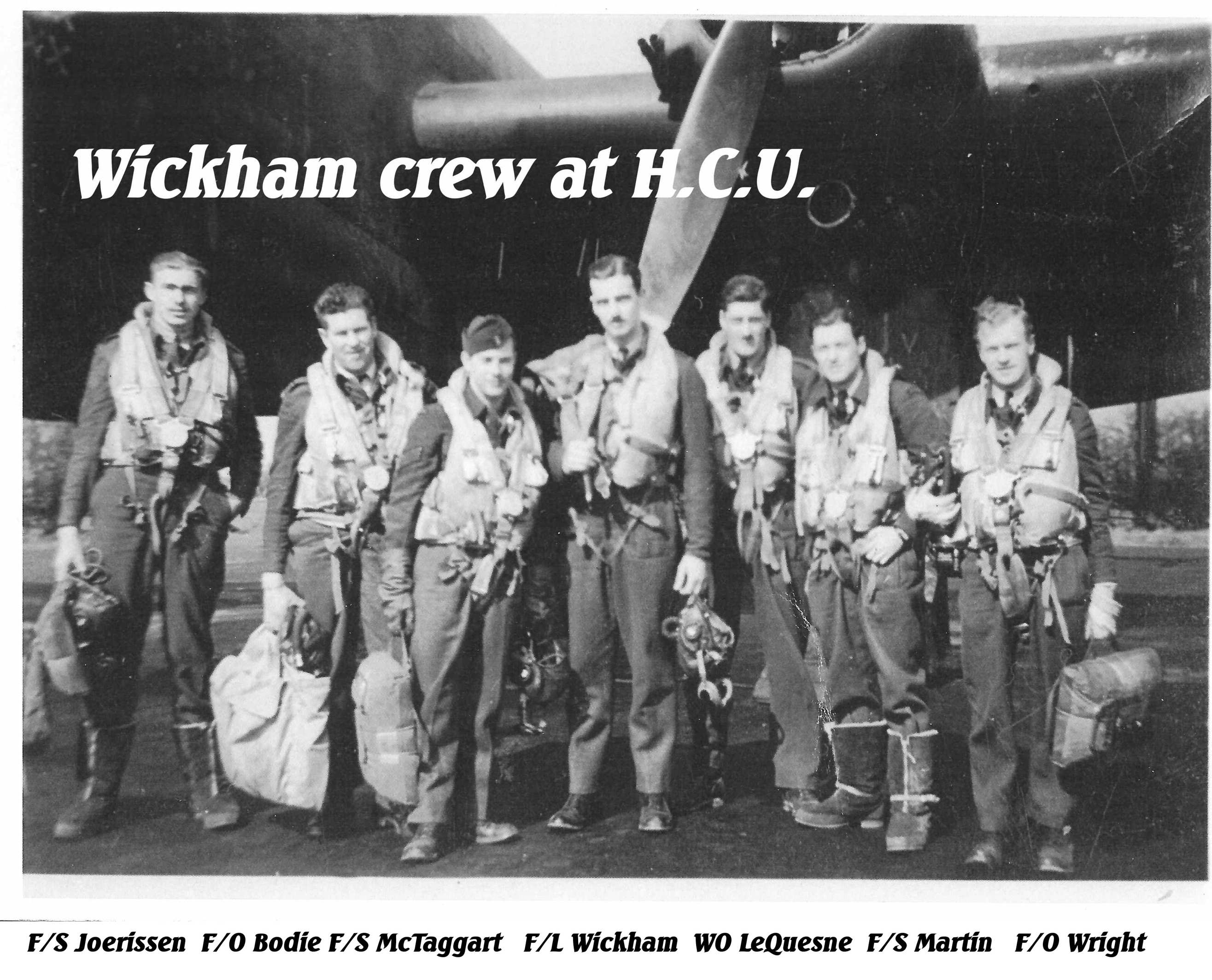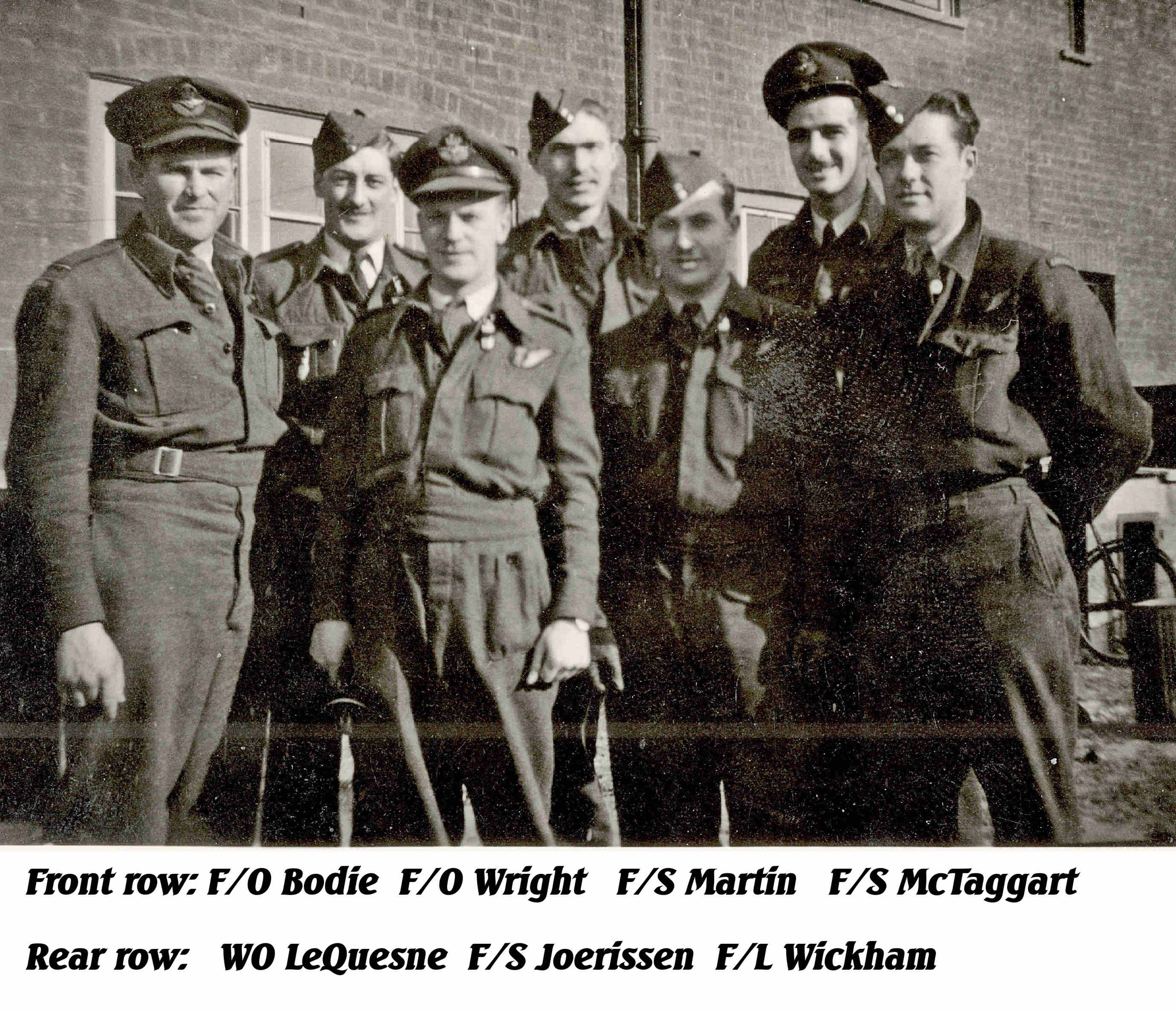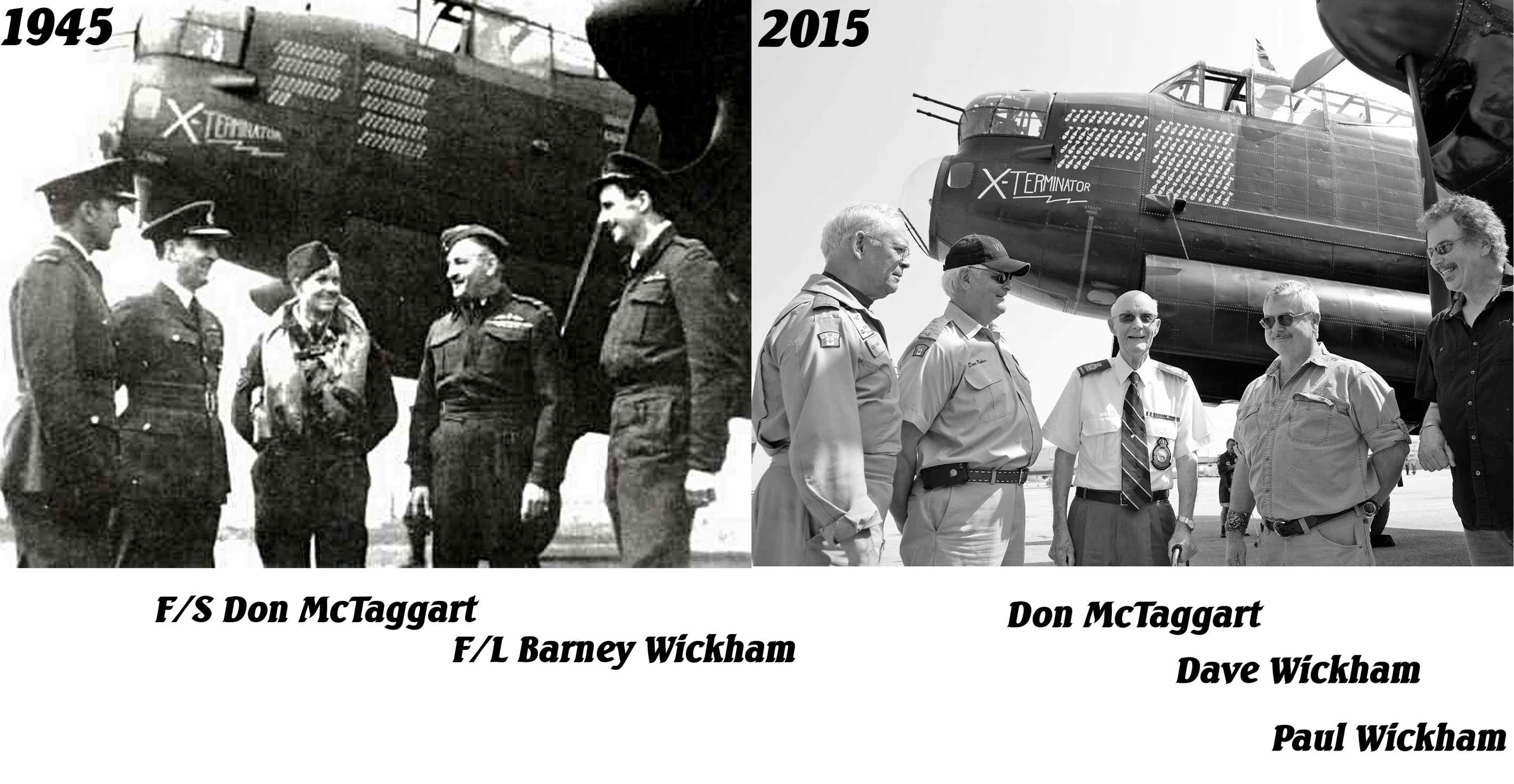
Enlistment
After Enlistment there was a period of waiting before being called up to report at a Manning Depot. A Manning Depot was where the change from civilian life to military life began for everyone joining the RCAF.
Whether ground crew or air crew the men would then be posted to an Initial Training School for selection of their future duties. The two paths would soon separate. Those who had selected and were accepted as aircrew in training wore a white flash in their wedge cap. The future airmen went under a series of more stringent tests designed to help the Selection Board decide on each man's mental and physical fitness. More through medical examinations thinned the numbers. Some of the testing was not unlike what today's astronauts under go. More so for those selected for Pilot training. Applicants would have to demonstrate signs of flying abilities as well as skills in leadership, math and under going a battery of physiological tests. Being the pilot, the Captain , of the aircraft meant being responsible for the safety of the men under their command. It was a pilots unspoken responsibility to stay with the aircraft until all the rest of the crew had safely left the the craft.
The Link Flight simulator would be the initial indicator in determining a man's ability to grasp the concepts of flying. It looked and worked similar to a carnival ride. Some men could handle it others could not follow the instructions fed to them by the instructors and lost control and "crashed" the ground based trainer.
Records were kept on every airmen. Gathered through observation of their actions carried out in scenarios built to test them under stress of command. The records would finally be presented to the Board.
EFTS Training
In August of 1940 LAC Wickham began his pilot training at Elementary Flight Training School on the single engine Tiger Moth, a cloth wing bi-plane which was a good starter aircraft. His strengths and skills had brought him through all that ITS had thrown at him. But more was to come over the next few months.
Pilot training was still at the mercy of the change from peace time to war time footing. Civilian instructors and commercial pilots were pressed into being instructors. The out come of this was a wide variation in the training and skills taught to the students.
For a number of pilot trainees, this would be the end of the line. Some volunteered to drop out at their own request. Others who were not as adept at flying as the Link testing had shown them to be were re-posted to other aircrew duties as determined by their secondary skills shown while at ITS.
Accidents were an expected part of life by a student pilot during this time. But the cause was not always the fault of a novice trainee A 1940 accident investigation branch report noted that more than 50 per cent of low flying accidents occurred while trained pilots, that is, instructors, were in command of the aircraft. A Funeral Parade brought forward the dangers and stark reality for those left to continue on.
SFTS Training
For LAC Wickham the next stop would be SFTS Service Flying Training School, flying in the RCAF way. Here trainees were piloting the more powerful Harvard mono-wing trainer. For Bomber Command's needs pilots were introduced to twin engine aircraft such as the Anson or the Crane. Continued evaluation and testing would again thin out the ranks of the those hoping to become pilots.
The completion of LAC Wickham's SFTS course was signalled by a Wings Parade in January of 1941,where he was promoted to Sergeant Wickham and received his Pilots Wings.
Post SFTS
With a shortage of pilots and instructors the RCAF retained some of the first to earn their wings for home based duties. In 1941 Wickham was posted to Trenton for advanced training before being posted to a Bomb and Gunnery School where he flew Fairey Battles.
Sgt. Wickham gained additional aviation skills as well as adding hours to his logbook from this posting. For over a year he served at No.1 Air Navigation School and at No.2 Air Navigation School. His ANS duty was to pilot navigation students on cross country runs. Navigation students sat in the back of the aircraft with all the windows screened off to them. Students were given information from the flight crew in the cockpit in this way caculated their positions. Students were expected to show to their Navigation instructor they could pin point the aircraft's present location at any time during the flight. The pilots who flew these rather boring exercises were not above laughingly feeding the wrong air speeds or bearings to the students which was not welcomed by the students or their Navigation instructors.
On July 1 1942 Sgt. Wickham was Commissioned with the rank of Flight Lieutenant in the Special Section General List Pilot Branch. This was a jump in Commissioned ranks by- passing Pilot Officer and Flying Officer. F/L Wickham's next posting was to No.124 (Ferry) Squadron. A welcome change from the boredom of two previous postings at AN schools. No.124 offered a challenge and a wealth of experience. Ferry squadrons flew a wide variety of aircraft from fighters to light bombers. Every day could be flying something new in different surroundings across Canada as well as the United States.
Overseas
Following his time with No. 124 Squadron Wickham would report to "Y" Depot in Halifax and await embarkation to the UK. The U-boat menace had not ended at this point in 1944 . Crossing the Atlantic on board even such swift ships as the Queen Mary or Queen Elizabeth was still a dangerous undertaking. Ships designed for 2,000 passengers were now filled by 8,000 or more service men and all their kit.
As noted by someone who had taken part on Life Boat Drills on one of the Queen's crossings. With a line of 6 men abreast hundreds of yards long leading deep down into the ships lower 5 decks chances of survival if torpedoed were very slim.
More Training
Once in Britain the world would be a different place for Wickham. A world of blackouts, air raids and rationing.
All RCAF personnel first posting overseas was to PRC# 3 at Bournemouth. Each man was billeted at a home, hotel or other over crowded place. Their meals were determined by what their ration books and hosts could scrounge up.
For a week or more the newly arrived airmen they would await posting to their next assignment. For pilots there was an RAF requirement that insisted on RCAF pilots taking Advanced Flying courses.
All the airmen were also subjected to Commando hand to hand combat courses run by the British Army. Whose instructors looked at this training as beneath their dignity which sometimes made the courses hard on the airmen in a number of ways.
When a new course began groups of these new arrivals were sent to an Operational Training Unit where they would become members of a crew assembled by one of the many new pilots. F/L Wickham then became Captain of a crew, a crew which he selected. Men who would spend the next month and a half or so learning how to work together to become a team. A series of day and night navigation and bombing exercises around the British countryside putting their skills into use . The crews still were not ready for posting to an operational squadron. One more step would be needed to be completed before squadron selection would be determined.
At a Heavy Conversion Unit (HCU) is where they would begin training on the four engine heavy bombers most likely worn out Halifax aircraft. It would be here where Sgt. Joerissen their Flight Engineer, whose duty was to assist the pilot with the operation of the aircraft, would join the crew. Now flying in larger aircraft then the Welligton they had first crewed the night and day exercises continued. The Flight Engineer now performed tasks that freed up the pilot to concentrate on his duties. The crew had to find their way around this new to them aircraft and be able to locate in the darkness of night escape hatches, first aid kits, fire extinguishers and reach one another in case of an emergency.
Bomber Command HQ would often select HCU aircraft to be used as a method to deceive the enemy radar. The HCU's did have numerous losses and fatalities during these operations even though they were designed to have them turn back before penetrating enemy defences. ( According to an interview with Don McTaggart many decades later Wickham and his crew had flown a "Windows" operation, dropping tin foil strips to jam German radar.)
At HCU F/L Wickham and his crew possibly flew in "Nickel" ops. A code name for dropping paper leaflets over the coastal countries under enemy control. These HCU operations did not count towards the crew's sortiesTour tally.
April 1945 - 419 Squadron
Pilot: F/L Bernard P. Wickham
Navigator: F/O A.R "Bob" Body
B/A: F/O William "Bill" Wright
WAG: WO Jack Le Quesne
F/E: Sgt. A. T. "Jerry" Joerissen
M/UG: F/Sgt.T.H. "Tom" Martin
R/G: F/Sgt. Donald "Don" Mc Taggart

The attrition caused by losses of crews and screening of crews who had completed their Tour decided which squadron RCAF HQ posted them to.
Near the beginning of April of 1945 F/L Wickham was posted to 419 Squadron.
The air war was drawing to an end and everyone sensed it. New crews were still arriving and were anxious to make use of their years of training before the air war ended. The dangers had not disappeared The war may have been ending in their minds but the squadron was still taking losses. On April 13th F/L Wickham took his 2nd Pilot op. flying with the Squadron CO Wing Commander Ferguson to Kiel. The 2nd. Pilot op. or 2nd. Dickie as the RAF called it was a war time version of on the job training. Flying with an experienced crew on a squadron operation deep into enemy territory. (It would be on this op. that 419 would lose KB866 and her crew.)
On April 16th as Captain and with his own crew on KB841 he completed a sortie on Hagen. Followed on April 22nd/23rd with a raid on Breman flying KB854 nick named "Trudy Terrific".
April 25th 1945 Wangerooge
April 25th would see the last operation by Moose Squadron. This one was to aid the Canadian troops in their last big push in Holland.
F/O Wickham's crew were assigned KB732 "X-terminator" on her 84th sortie. She was the Grand Old Lady of the Squadron. And as such it brought out the Base top brass and Air Vice Marshall McEwan for a photo session. F/L Wickham and F/S McTaggart were also part of this well published photo.
KB732 was now showing her age and lack of power. At take off F/L Wickham needed to gain height and set course directly to the target bypassing the normal pattern of climbing and circling to the assigned altitue for course correction to the target.
If F/L Wickham had not completed this style of straight line climb the bomber would have been late arriving at the target and be the only target for the anti-aircraft guns.
As it was operation was marred by the loss of six aircraft due to collisions. Including one in which two Lancasters crashed into each other then hit two other Lancasters. The flak was described as heavy over the target but all 419 aircraft returned to base.
With her slow speed "X-Terminator" was the last 419 Lancaster to touch down at 2010 hours.
( It must have been a situation known to the Squadron Engineer, that KB732 was not fit for this last assignment. And should have been left behind. To myself it appears as a danger to the crew. It was a good choice to have Wickham with so much experience at the controls when this could have been a tragic mistake to continue with KB732 until she had overhauled)

In the Words of Jerry Joerissen
"We had been sort of stood down regarding bombing as our armies were nearing Berlin. When the Canadian Army found that the Germans had turned around the naval guns on Wangarooge and were using them as artillery to fire on the Canadians, they asked Bomber Command to knock them out. "We were told to plaster those islands so they looked like the coast of Normandy with nothing but craters showing, and end artillery fire on the Canadians in Germany. "I saw two bombers collide on our port side on the way to the target. The ‘grapevine’ story after the raid was that one of the pilots had been a student of the other back in Canada and they were trying to do some formation flying because there was no danger from German fighters. What they didn'’t realize was that a stream of 500 Lancasters creates a lot of turbulence. "We were a sprog crew and did not have our own Lancaster so had to fly any spare one that was serviceable. It just so happened we put mission 84 on X-Terminator."
A Long Journey Home
Comments in the Operational Records Book summary section for May range from notes of "bags of rumours of Hitler is dead" and for each day the words "Stand Down" show that the air war was indeed over.
By May 6th words of extensive training for the Trans Atlantic crossing were found on the ORB pages. Unusual comments on all Leaves cancelled and those already on Leave to be recalled for Commando training seem odd for this point in the war.
Selected crews were assigned the task of bringing home the Lancasters of 419 Squadron. F/L Wickham was chosen for one of these. Wickham was assigned VR-Q as his responsibility to return to Canada. For F/L Wickham and several of his crew it was back to more training. The journey back to Canada would require training in Astro Navigation and following Commercial air travel polices.
First step in the actual journey would the 3 hour flight from Middleton St. George to RAF St. Mawcan, the most southerly RAF Base in Britain. The next day would be a gruelling eight and a half hour flight to Lagens in the Azores.
After a three day layover another long haul from the Azores to Gander Newfoundland. This would take eight hours plus over the Atlantic Ocean. The next day from Gander to Yarmouth Nova Scotia.
On June 10th 1945 16 of 419's Lancasters were back home. By June 16th the final three Lancasters of 419 were back in Canada.

